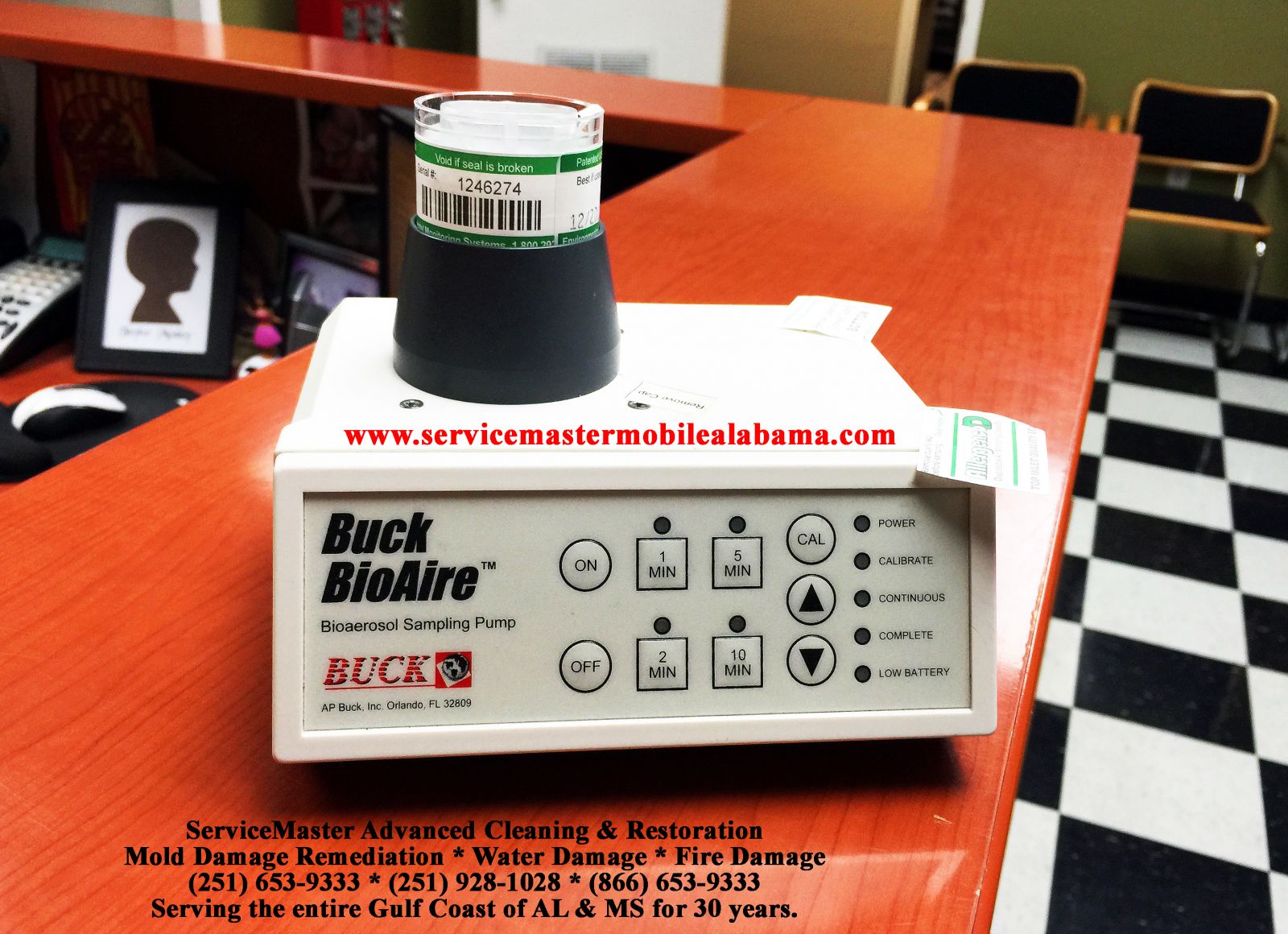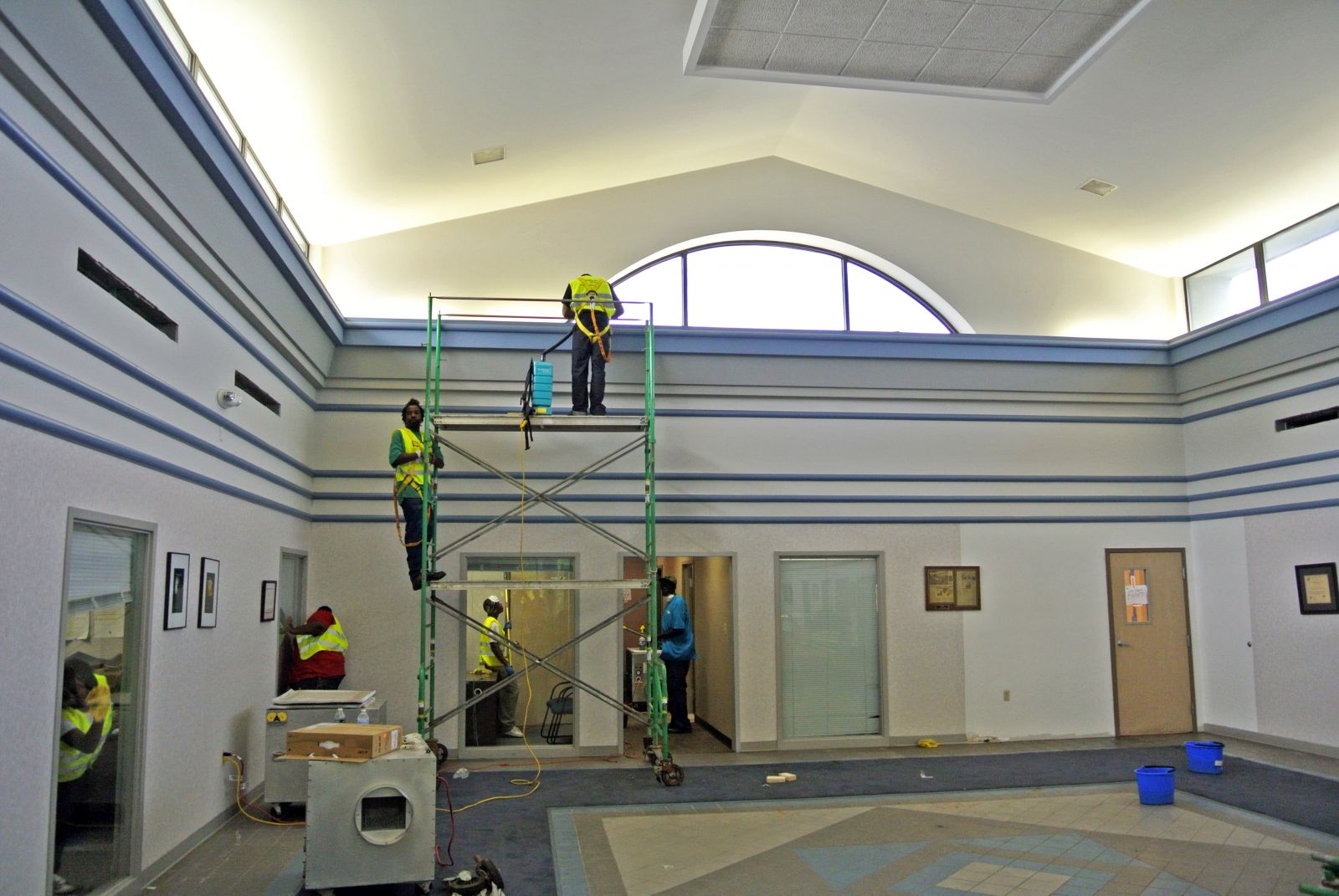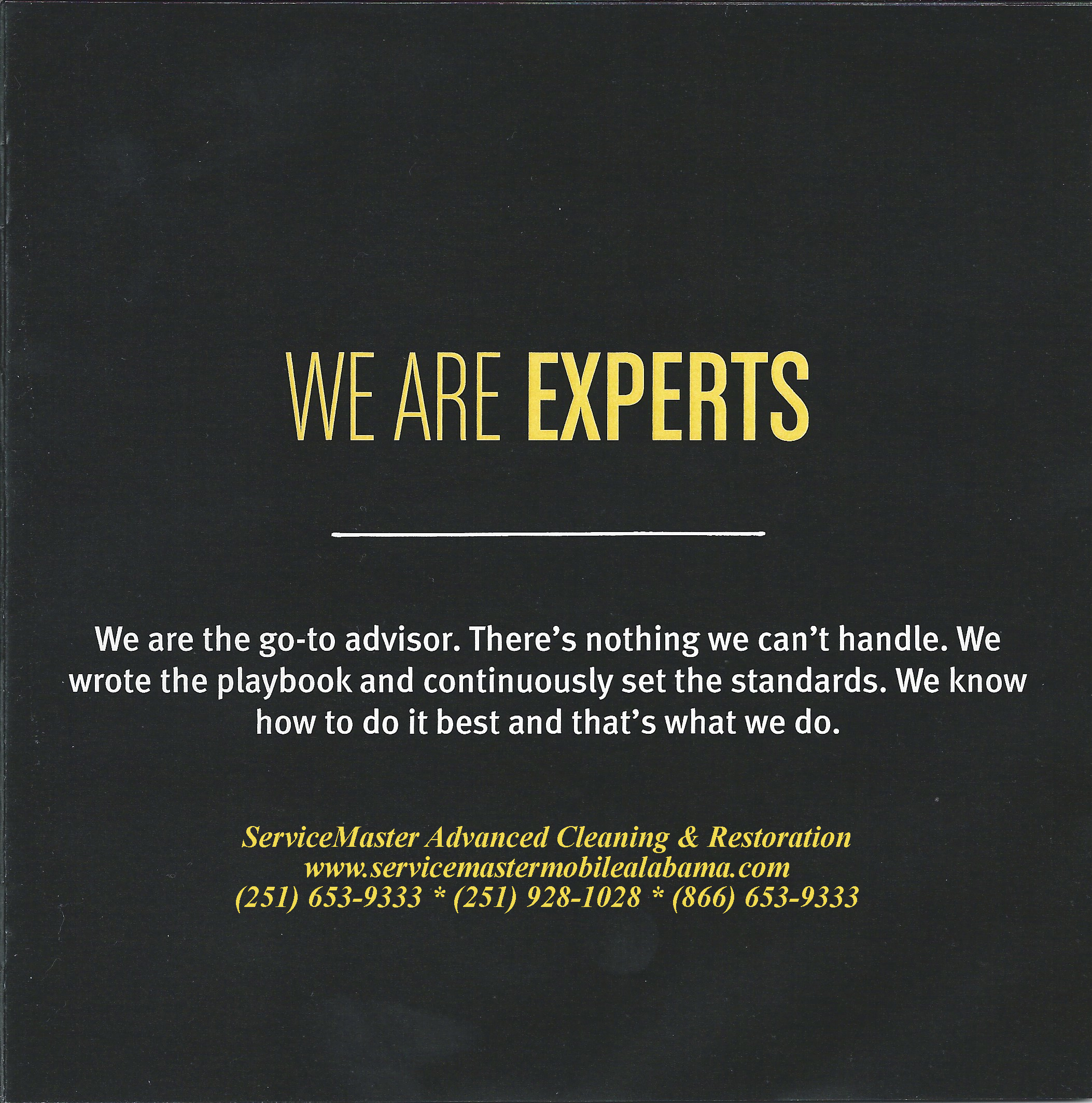Advice on Mold Contents Cleaning
If you have a mold issue, make certain that you hire a CERTIFIED mold remediation professional. Ask to see their certifications. Ask to see their insurance. Mold can be a serious health hazard, and you shouldn't take a chance with anyone that says it can simply be torn out! The airborne spores left from the removal of affected drywall and contents, are typically the very thing that will cause health problems. If every square inch isn't properly cleaned and the air filtered, the resulting spores can be enough to cause serious health issues. We will not take a chance with your health. We only know one way to do the job - the right way. This involves total elimination and removal of all visible and airborne mold spores. - ServiceMaster Advanced - The Master of Disaster (251) 653-9333, (251) 928-1028.
We have posted many articles and videos on our web site http://www.realmasterofdisaster.com. Also, we have posted an excellent article that details they types of mold and the potential health effects here: http://www.servicemastermobilealabama.com/CERTIFIED-Mold-Remediation-Requires-Training-Knowledge-Mobile-AL.html
Over the years, people have asked us if it is OK to keep and clean mold damaged contents themselves. Obviously, this is a situational issue, but the following article may be of some assistance.
How To Clean Mold Contaminated Contents!
Article originally published on August 22nd, 2015 at www.moldsensitized.com
The Contents Conundrum*
This article was originally published by Contents Industry Review, Your Source for the Latest Contents Restoration News, Trends and Developments. Many thanks to David Gavilanes for his assistance. Image courtesy of Contents Industry Review.
Deciding if contents from structures with mold growth are contaminated, and what to do about them
Too often, contents are the forgotten stepchild of a mold remediation project. Inspectors and Indoor Environmental Professionals often focus on identifying the source of water intrusion and the subsequent fungal contamination with little regard for the furnishings and contents in the areas surrounding the contamination. Many project specifications talk about isolation of contaminated area with brief instructions (or the assumption) for movable contents to be repositioned so that they are not inside the isolated work zone.
Unfortunately, improperly assessed or addressed contents can be a source of significant cross-contamination to areas where considerable effort and expense has been expended to deal with mold contamination. This is an especially crucial issue if any of the occupants aresensitized to mold (or have Lyme disease or chemical sensitivity, either of which can result in cross sensitivities to mold). Therefore, regardless of whether the contents are addressed in the work plan of a third-party, cleaning and restoration contractors need to have some basic guidelines for attending to them when dealing with water damage and mold remediation projects.
The Initial Assessment
Even if contents are only being moved from one area to another as part of the setup for a mold remediation project, close attention should be paid to each and every item. Any material that has visible fungal growth (or anything that resembles fungal growth), a musty odor, or a “light fuzz” that could be dust deposition or mildew should immediately be segregated from the other materials. Of the items with visible contamination, nonporous materials can generally be cleaned satisfactorily. In contrast, the current standard of care calls for the disposal and replacement of soft, porous contents that are supporting fungal colonies.
Even if the contents do not have visible growth on them, they could still be reservoirs of fungal contaminants like spores, hyphae, and mycotoxins (chemical poisons that can be released from some fungal types). This microscopic contamination is characterized as Condition 2 by the IICRC’s S520 standard related to professional mold remediation. The S520 notes that dust from impacted items does not reflect the “normal fungal ecology” in terms of fungal types present and amounts. However, the good news is that the S520 document explains that contents contaminated by deposition of spores from adjacent growth can be cleaned.
Standard of Care versus the Doctor’s Recommendation
While many professionals in the cleaning and restoration industry are used to cleaning contents that at first glance seem to be unsalvageable, the reverse thinking often takes hold of occupants who are dealing with a mold contamination situation. Even in cases where the contents do not have visible fungal growth, they are concerned that the materials cannot be thoroughly decontaminated. Indeed, we have talked to several individuals, diagnosed with mold sensitivities, who were told by their doctors that the contents of their homes could never be cleaned well enough. The medical professional basically told them that all of those items needed to be disposed of.
In contrast, our research and experience confirm that contents acting as a reservoir for fungal contamination generally can be cleaned. However, from a practical and financial standpoint the general rule of thumb that we use when offering advice to clients is that the more contents that can be removed from the house, the more thorough the cleaning of both contents and the structure can be. Nevertheless, there are practical limitations. Large bureaus, beds, couches, and appliances are difficult to move, even to a cleaning station in the garage. Large pieces that are left in the house need to be thoroughly cleaned and then moved multiple times during the process of cleaning the structure. We do not recommend that they be covered and left in place because this hinders the proper cleaning of all surfaces.
Another important consideration is that the more consistent the occupant and cleaning contractor can be with surfaces and contents, the better the result for sensitized individuals.For both surfaces and contents, the process should begin with a HEPA sandwich method of cleaning. Additional activities for both the structure and any remaining contents can include air scrubbing, air washing, and fogging.
Using a Logical Process
As most cleaning and restoration contractors understand, once the decision has been made to undertake cleaning of some or all of the contents, a number of other questions come into play.Probably the biggest variable that needs to be determined is where and how the content cleaning will be accomplished. There are a few options:
1. Clean them on the way out of the house. This typically involves setting up a cleaning station in the garage or other area where contaminated contents from the house are staged, cleaned, and packed in clean containers. Although we prefer that plastic tubs with tightfitting lids be used as storage containers, cardboard boxes can be used as long as they are lined with plastic to protect the contents from moisture. Generally, the packing containers used on the way out of the house are not an issue—even old grocery boxes can be used, but after the items have been cleaned they should be stored and moved around in new boxes or plastic containers.
Some clients have even gone so far as to set up a washer and dryer in the garage with temporary water and power sources so that methodical cleaning can be conducted. We recommend, however, that any soft contents being saved be cleaned using the Esporta Wash System rather than regular washers and dryers. This is because that is the only system that we are aware of that has published data on the efficacy of cleaning mold reservoirs (as well as actual visible contamination) from soft goods.
2. Pack them and have them cleaned at a separate facility. The benefit to this approach is that the contents can then be cleaned utilizing a wide variety of specialized decontamination processes. In particular, this allows materials to be moved to a facility that has specialized laundry equipment, ultrasonic cleaning tanks, proper cleaning equipment for electronic components, and even areas for specialty cleaning of papers and books. Also available at some facilities, household contents can be subjected to other cleaning and decontamination procedures as appropriate, such as controlled exposure to ozone or hydroxyl radicals.
3. Pack the contents, store them until remediation has been completed, and then clean them on-site as they are moved back into the clean residence. While this approach has the benefit of the items being cleaned immediately before their reentry into the remediated structure, it does limit the cleaning methods that can be used. The biggest drawback to this approach is that many of the specialized cleaning procedures mentioned in the previous option are not practical at temporary locations.
Once a decision has been made as to how and where the contents will be cleaned, it is much easier to proceed with packing. In all cases, it is best to view this situation as an opportunity for the clients to de-clutter their lives. Content cleaning gets progressively more expensive as the number of items increases. Also, it is important to educate the client that, from a mold perspective, paper goods are the most difficult to clean properly and, therefore, are the most expensive. But for almost everything else, studies have shown that cleaning contaminated items costs only 20–25% as much as replacing them.
Selection of Cleaning Products/Processes
Regardless of whether it is hard goods or soft goods, a decision needs to be made about the particular cleaning agents that will be employed. While a good HEPA vacuum should always be used to remove loose particles from contents, a damp or wet cleaning method is also recommended for materials from a mold-contaminated structure. One of the primary reasons for this washing is the debate in the industry about what role residual mycotoxins play in the development of adverse health symptoms. Research over the past seven years has shown that some of the more noxious mycotoxins can not only be spread through the air, but when they settle on surfaces they tend to cling to that surface until the attraction is broken through chemical and physical methods. (This means that if there are sporting goods, such as a croquet set, in a mold-contaminated environment you could have a real sticky wicket on your hands!**)

.jpg)
For this reason antimicrobials that are formulated from quaternary ammonium compounds (quats) are often recommended for cleaning contents and surfaces in mold contamination situations. Quats are recommended for mold work because some research suggests that they are better than regular cleaners at removing mycotoxins from surfaces. Nevertheless, the oxidation potential of hydrogen peroxide based cleaners would, theoretically, also work to break that sticky bond between the mycotoxins and the surfaces.
Essential oil cleaners are another frequent choice for mold work. While their effectiveness against microorganisms is well documented, there is little available evidence about their ability to remove mycotoxins. Another class of cleaning products being used for mold remediation are salt-based products. However, once again, there is little available evidence about their ability to remove mycotoxins.
Cleaning Contents May Not Be a “Do It Yourself” Proposition
People who are considering cleaning household contents related to mold contamination situations for the first time rarely think that there is any sort of conundrum associated with the work. The reality is that cleaning these contents can pose a variety of unexpected difficulties and needs to be well thought out.


While this article contains a lot of information to digest, it also points out that the cleaning and restoration industry is blessed with a great variety of good products that work well in specific aspects of the mold remediation business. Contractors and occupants just have to choose wisely based on their particular situation. For sensitized individuals, this may mean that what at first appears to be a simple task of cleaning dust and fungal reservoirs from contents is actually something that they should leave to the professionals.


Remember that YOU AND YOU ALONE, decide who works in your home or business. YOU decide who handles your most precious of possessions! Tell your insurance provider that you want SERVICEMASTER ADVANCED or call us directly. Make sure that there is no confusion. There are other mitigation companies, and even others with similar sounding names. We are ServiceMaster Advanced, The Master of Disaster. "WE WOULD BE HONORED TO SERVE YOU." (251) 653-9333 or (251) 928-1028.
